
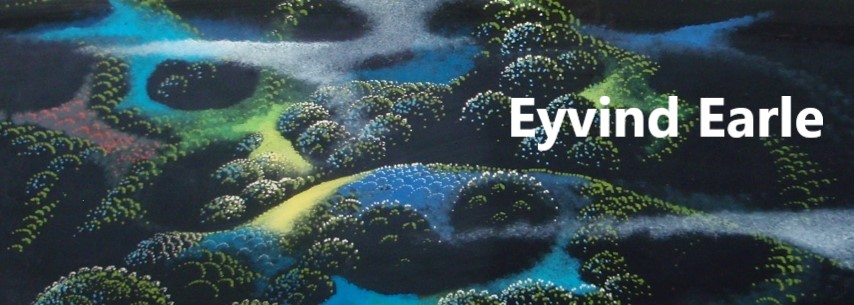


|
Artist Eyvind Earle received the Disney Legend Award in Anaheim, California August 24, 2015. Fellow 2015 inductees included George Lucas, Johnny Depp, Susan Lucci, George Boden Heimer, Andreas Deja, Danny Elfman, Julie Reihm Casaletto and Carson Van Osten. Including this year’s honorees, a total of 257 Disney Legends have been named. Past Disney Legends include Tim Allen, Robin Williams, Julie Andrews, Howard Ashman, Regis Philbin, Annette Funicello, Peter Jennings, Angela Lansbury, Steve Martin, Alan Menken, Hayley Mills, Fess Parker, Sir Tim Rice, Dick Van Dyke and Barbara Walters. |



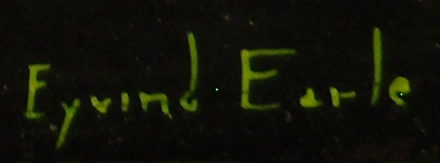
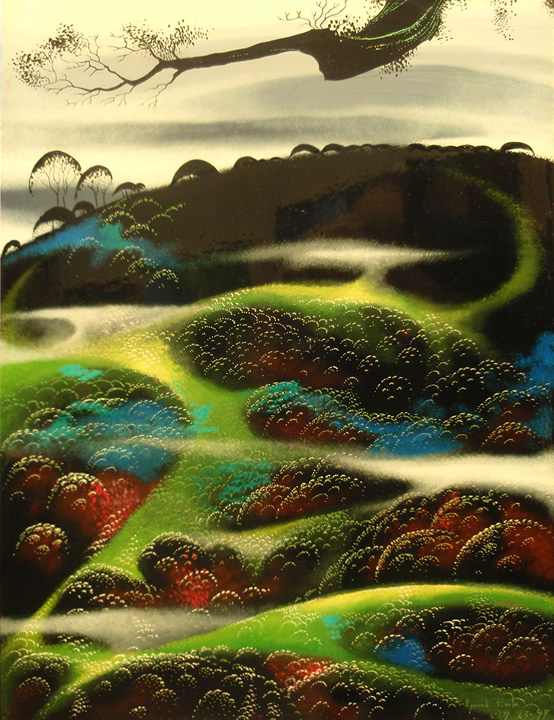
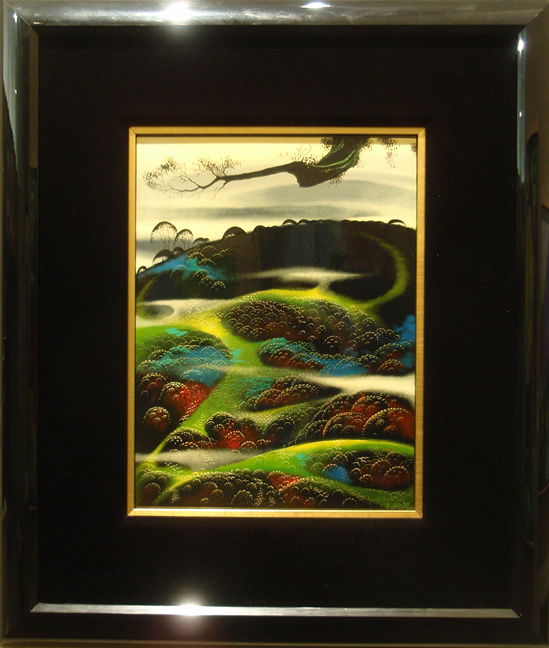


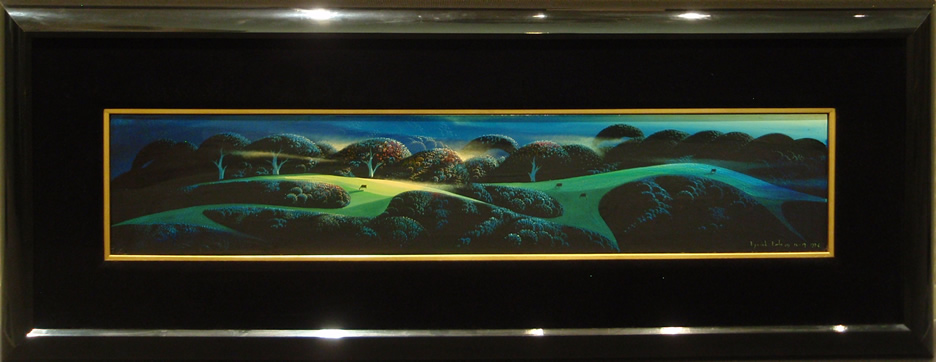

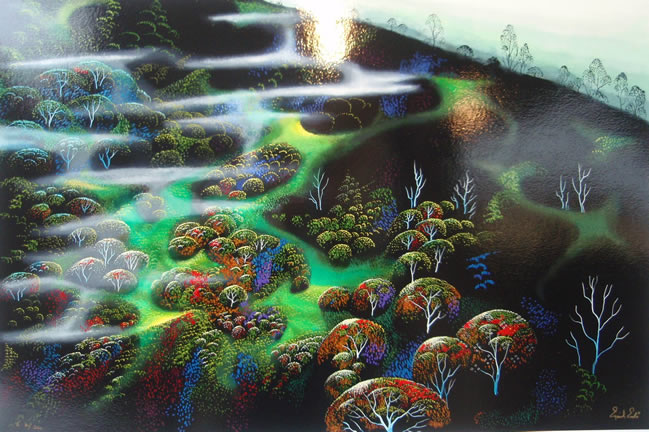
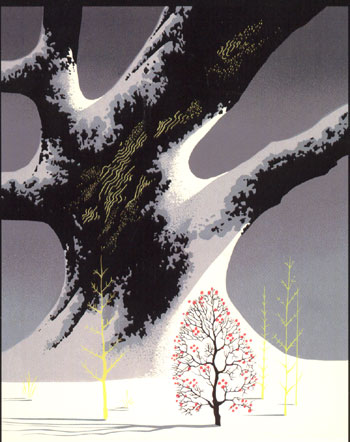
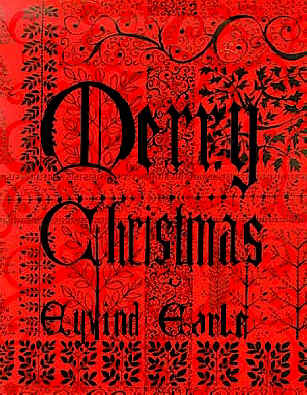
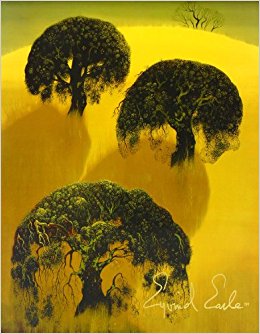
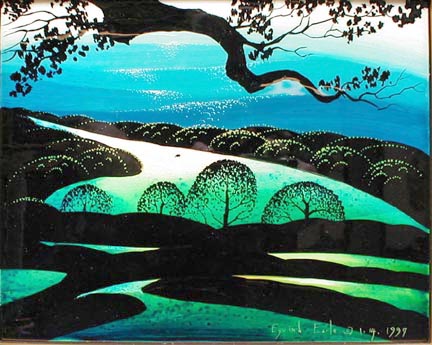
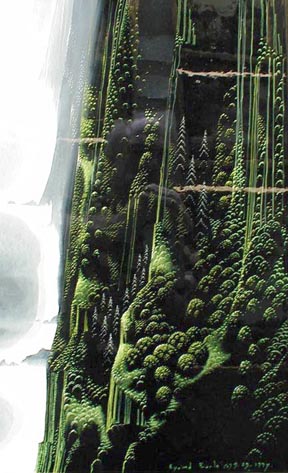
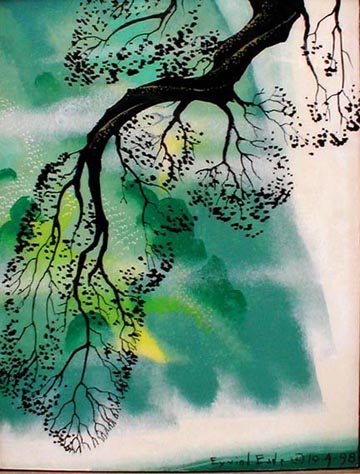
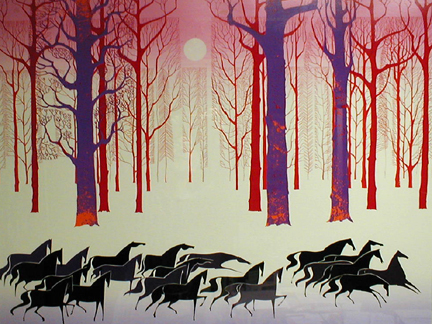
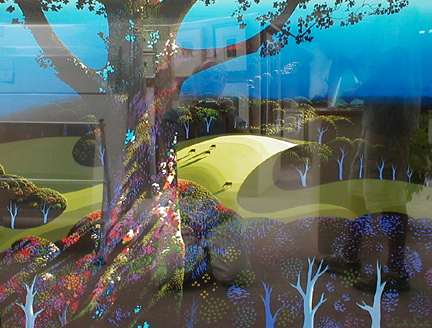
|
Born in New York in 1916, Eyvind Earle began his prolific career at the age of ten when his father, Ferdinand Earle, gave him a challenging choice: read 50 pages of a book or paint a picture every day. Earle choose both. From the time of his first one-man showing in France when he was 14, Earle's fame had grown steadily. At the age of 21, Earle bicycled across country from Hollywood to New York, paying his way by painting 42 watercolors. In 1937, he opened at the Charles Morgan Galleries, his first of many one-man shows in New York. Two years later at his third consecutive showing at the gallery, the response to his work was so positive that the exhibition sold out and the Metropolitan Museum of Art purchased one of his paintings for their permanent collection. His earliest work was strictly realistic, but after having studied the work of a variety of masters such as Van Gogh, Cézanne, Rockwell, Kent and Georgia O'Keefe, Earle by the age of 21, came into his own unique style. His oeuvre is characterized by a simplicity, directness and surety of handling. In 1951 Earle joined Walt Disney studios as an assistant background painter. Earle intrigued Disney in 1953 when he created the look of "Toot, Whistle, Plunk and Boom" an animated short that won an Academy Award and a Cannes Film Festival Award. Disney kept the artist busy for the rest of decade, painting the settings for such stories as "Peter Pan", "For Whom the Bulls Toil", "Working for Peanuts", "Pigs is Pigs", "Paul Bunyan" and "Lady and the Tramp". Earle was responsible for the styling, background and colors for the highly acclaimed movie "Sleeping Beauty" and gave the movie its magical, medieval look. He also painted the dioramas for Sleeping Beauty's Castle at Disneyland in Anaheim, California. Earle's work was also seen on television. One of his animated creations was an 18-minute version of the story of the Nativity that he did in 1963 for Tennessee Ernie Ford's Special "The Story of Christmas". A Daily Variety reviewer said Earle's sequence "should be preserved and played back for years on end." The show was digitally re-mastered in 1997.Earle's career has encompassed many different fields. In addition to book illustrating, the artist had also designed a number of covers for magazine publications and had produced and created several animated commercials and specials for television. In 1998, at its Annie Awards show in Glendale, the International Animated Film Society gave Earle its Windsor McCay Award for lifetime achievement. In the 1940's, Earle adapted his creative landscapes to Christmas cards, painting more than 800 designs that have sold more than 300 million copies through American Artist Group. After about 15 years creating animated art, Earle returned to painting full time in 1966 and kept working until the end of his life. In addition to his watercolors, oils, sculptures, drawings and scratchboards, in 1974 he began making limited edition serigraphs. Eyvind Earle had a totally original perception of landscape. He successfully synthesizes seemingly in-congruent aspects into a singularly distinctive style: a style, which is at once mysterious, primitive, disciplined, moody and nostalgic. He captures the grandeur of simplicity of the American countryside, and represents these glimpses of the American scene with a direct lyric ardor. His landscapes are remarkable for their suggestion of distances, landmasses and weather moods. "For 70 years," Earle wrote in 1996, "I've painted paintings, and I'm constantly and everlastingly overwhelmed at the stupendous infinity of Nature. Wherever I turn and look, there I see creation. Art is creating...Art is the search for truth. "Eyvind Earle passed away on July 20, 2000 at the age of 84. During his lifetime he created many paintings, sculptures, scratchboards, watercolors and drawings that have not been publicly seen or exhibited. Eyvind Earle Publishing LLC, under the specific instruction of the late Eyvind Earle, will continue the legacy of the artist, promoting and introducing new serigraphs and books through galleries worldwide. These posthumous limited edition serigraphs will be printed from the oil paintings created by Eyvind Earle that are in the collection of Joan Earle and others. |
|
About Eyvind Earle
In one brief act of light and shadow, nature can become striking and beautiful. A tree outlined by the setting sun--its bark scored deeper by shadows and its whole shape thrown into silhouette---is somehow more than a tree. Its image haunts us, and we look afterward to find the same magic in other trunks and branches. Photographers speak of sitting with camera and tripod all day to catch the right light, so that a picture will come alive. This is the light with which Eyvind Earle imbues his landscapes. Earle's paintings and his serigraphs--screen prints which use paint films rather than printing-ink stains in the color areas, constitute a single body of work, for each of his prints is based closely on a painting, and all but two are landscapes. Large geometric forms predominate: trees pressed flat against the foreground, angular barns, and the receding curves of the horizon. On these forms, Earle imposes detail that is both realistic and decorative, hinting here of the Flemish Masters, there of the Japanese printmakers: scored bark, weathered planks, the tracery of shadows. This fusion of realism with design removes his landscapes to a supernatural realm. Many scenes are unmistakably Californian; yet the viewer senses right away that they are not of this world. Branches may at one time have been twisted by wind or weather, but each scene is now completely still. We never see the sun; yet Earle makes its presence tellingly felt, often placing one large tree directly against the source of light. The trunk both shows off the brightness and obscures it, enhancing the mood of mystery. Over the years, critics have praised Earle's technique, noting his delicate glazes and meticulous attention to detail. Whether painting or printmaking, Earle shows that he has studied his medium and knows its every nuance. However, the real power of his art comes from a profound conviction of beauty. The French landscapist Pierre Henri de Valenciennes once wrote that the greatest artists are those who, "by closing their eyes, have seen Nature in her ideal form, clad in the riches of the imagination." Earle captures the spirit of his subjects. Joining vision and artistry, he makes us feel the majesty of lone trees and the ghostly presence of evening shadows extending across a field. Since 1978, Earle had lived with his second wife, Joan, in a three-story house in the woods of Westchester County, New York. Just behind their home runs a stream, regulated by a weir which creates a pleasant waterfall. If he wanted to paint from life, Earle would need only to step out the door. But for years now, the pictures, as he puts it, "have simply come out of me, like speech. Pattern develops by itself, and I let the creative spirit within do the creating." Inside, the walls of every room are hung with paintings, turning the house into a gallery of the imagination. Any Earle painting is galvanizing at first sight, and 65 of them are difficult to absorb at once. Yet a peacefulness follows the initial impact, and the artist appears to draw refreshment from contemplating his own work. "I have a painting of a tree hanging over the couch right now," he says, pointing. "Every evening, when I put out the light and look at it, I'm amazed at anyone having done such a painting and wonder why I was given the chance. It started as a eucalyptus tree, but it's not one anymore--although it's not any other tree. It's a eucalyptus multiplied by a thousand. Make something out of that." A converted three-car garage next to the house serves as Earle's studio, and it is already too small for his projects. In January 1982, as if to mark the beginning of a new year, he called a temporary halt to painting, assembled new screen-printing equipment, and began to make prints entirely on his own. Earle did his own color separations, as he has done since the early 1970s when he first created large serigraphs from his designs and had them distributed nationally. "I have a tendency to be like my father," he admits. "I want to do everything by myself. The minute I get into something, I have to go the limit. If I started to sculpt in clay or stone, I could so easily abandon all other forms of art." Earle's father, Ferdinand, was a professional painter who studied with Adolphe William Bouguereau and James Abbott McNeill Whistler. Ferdinand Earle groomed his son as an artist from childhood, undertaking the boy's education with an old-school emphasis on practice making perfect. At the age of ten, Eyvind Earle's parents divorced, and his father hauled him off from California, first taking him to Mexico City, then on junkets around Europe. Once abroad, Ferdinand set his son a choice: read 50 pages or paint a picture--daily. Eyvind chose to paint, and the two would work together each day on the same subject. "He never explained anything," Earle recalls. "I would always finish long before he did, so I would simply stand and watch him for hours." By the time the artist was 14, he was good enough to have a public showing in Ascain, a small town in the south of France. "I really had very little talent," he admits, "but at the time, I was quite conceited. Everybody said 'ooh' and 'ah,' because no other kid had done hundreds of paintings." Several months later, Earle ran away from his father, using shopping money to buy a train ticket to Paris. With the help of his half-brother, Harold, Earle returned to the U.S., joining his mother in Hollywood. During the next seven years, Earle squeezed through the Great Depression earning nickels after school by painting house numbers on curbs and by taking on chores such as roofing and mixing concrete. The Depression years were interspersed with a few strokes of good fortune, as in 1936 when Grace Tibbet, wife of the opera singer Lawrence Tibbet, offered him $25 a month to go to Mexico and paint for a year. Before receiving this commission, Earle had managed to become, for a time, an assistant sketch artist at the United Artists studio--foreshadowing the years he would spend in the 1950s working for Walt Disney {beginning as a background painter and rising quickly to the position of art director on Sleeping Beauty} and the years after he left Disney to produce, paint, and photograph animated films and commercials with his own company. In 1937, at the age of 21, Earle set out for New York on his bicycle, painting a watercolor on each of the 42 days it took him to cross the continent. Only a year later, the Charles Morgan Galleries held a show of the paintings to critical acclaim, and the gallery continued to show his work each year. In 1940, The Metropolitan Museum of Art bought one of his watercolors for its permanent collection. That painting, entitled Weatherbeaten, depicts a lone farmhouse and a stand of bare trees, with the spring snow beginning to thaw into patches of mud. The scene lacks the visionary quality of Earle's mature work, but long fingers of shadow and one gaunt tree hint at his later landscapes. 1940 was also the year when Earle began his work with serigraphy. In Stamford, Connecticut, he founded his own Christmas card company, designing the cards and making them himself. At first, he printed by hand from linoleum blocks, then graduated to screen printing as well. "I never had a lesson in serigraphy," he confesses happily. "I learned by doing the Christmas cards. You go to the store and buy the materials, and you get a little instruction book. It isn't very complicated." Earle's life of screen printing cards was interrupted in 1943, when he was drafted, but after two years of service, he returned to New York and soon afterward was creating designs for the American Artists Group, a greeting card firm. The company has since sold millions of cards, reproducing over 600 of Earle's designs. "I've found," says Earle, "that the wonderful thing about screen printing is the inventiveness you can exercise with it. You can decide to do a thousand things as you print, like those thin, transparent glazes that shade from light to dark, or from a color to totally transparent. You can do things yon couldn't do any other way. Try grading the color along a narrow line of paint! You can imitate a painting with a screen print, but you can't imitate a screen print with a painting. "I no longer copy paintings, but make up completely new pictures as I go along. Many times I add things, just as if I were painting, and I don't know what a picture's going to be like until it's done. Perhaps I should give the result a new name--'screen paintings.' These may be my art form, as wood-block prints were for the Japanese." Invited to describe his creative process more fully, Earle speaks in mystical terms. A student of yoga since the age of 16, he began work for many years by meditating and then rushing to the canvas to paint the beautiful scenes which appeared to him. "Now I don't have to meditate. I simply know that if I start with a pencil or brush, some higher intelligence will direct my work. Having discovered that, I no longer make an effort to interfere. There is a great force pulling us, and the more it manifests, the more creative we become. Art is an attempt to delve into this mystery, to pick one detail out of the infinitude of infinities and make it clear. "I don't try to convey an idea or emotion, and I'm not at all interested in art that is supposed to reflect our times. Greek art, which is as excellent today as when it was created, certainly doesn't reflect Greece 2,500 years ago. It simply is beautiful, superior possibly to any sculpture done since." As if to goad himself to the perfection of his own art, Earle clips and keeps reviews of his contemporaries. "The colossal conceit of many prominent modern artists--such as most of the so-called New York Expressionists--is almost beyond comprehension," he declares. "They are satisfied creatively by daubing huge canvases with sloppy slashes of raw color, empty of design or draftsmanship, void of emotional content. I have chosen at this time to devote my painting efforts towards perfecting to the utmost of my capacity whatever paintings I still possess or new ones I create. I shall strive to make them the sum total of my being." Until 1966, Earle had worked with casein on Masonite, a very sensitive medium, but then he began exhibiting and switched to acrylics. "I loved the casein," he recalls, "but I gave it up because it's so easy to damage. A fingerprint on it can mar the surface, and there's no way to get it off. Walking through museums, I see many modern works, by painters who are still alive, that are cracking and chipping. Do these artists think it beneath them to consider the preservation of their work?" Earle extends this concern to his own prints and paintings and is "still trying to perfect the preservation side of my work." Once, as a test, he tacked a serigraph to an outside wall and left it there in sun, wind, and rain for two years. Then he removed it to scrutinize the inks for fading or leaching and to test the paper for flexibility. The print was still bright and supple. "It's very important to ensure that a piece won't deteriorate 50 years later," he insists. Earle had painted entirely in oils since 1972, when he ran out of the fast-drying, brilliant black he preferred for acrylic work. In June 1983, a year and a half after he shifted to full-time work on his serigraphs, he resumed oil painting. Then just a month later, Earle finally found a satisfactory acrylic black, bought a hundred bottles, and set to work in acrylics as well. He continued to produce serigraphs until he died in 2000 --his "screen paintings"--earning financial and critical success in an age when loveliness has nearly become passe. While other artists strive to impress with anger or social relevance, or to beguile with nostalgia, a public weary of the present and doubtful of the future, Eyvind Earle pursued beauty. This quest predates the Greeks, but Earle's strength of vision and craftsmanship made it compellingly his own. |




433 Albert Avenue East Lansing, Michigan 48823 USA (517)351-0815